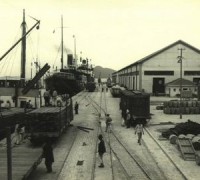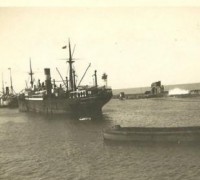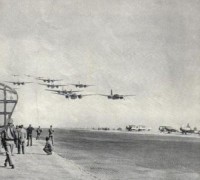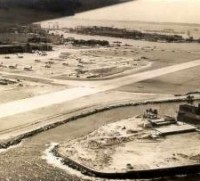BRAZIL THE FORGOTTEN ALLY - BRAZIL X USA
2)MILITARY INVOLVEMENT
WHAT DID YOU DO IN THE WAR ZE CARIOCA?
By Frank Mc D. Cann. University of New Hampshire.
American willingness to commit financial, technical, and physical backing for Brazil's industrialization derived from more than concern over German trade proposals. Throughout 1940, Washington had grown steadily more alarmed at the European situation. With the fall of France, it took seriously the possibility that if Britain collapsed, Germany might launch an attack on the Western Hemisphere. Berlin did not have such plans, but in mid-1940 anything seemed conceivable, and it was perhaps best to imagine the worst. In late May, reports of a pro-Nazi coup plot in Argentina and a British report of a possible German move against Brazil galvanized Washington.
Roosevelt ordered the army to plan operation Pot of Gold, that would rush a 100,000 man force to secure points from Belém to Rio de Janeiro. The Brazilian military was decidedly cool to the idea of letting American troops into the country, and Pot of Gold did not go beyond the planning stage, but continuing conversations over the next two years led to permitting American naval and air bases.
Interestingly enough, though the steel mill agreement was crucial to close Brazilian-American ties, four days before the agreement was signed in Washington, on September 26, 1940, the Vargas government decided that, in case of German aggression, it would place all of Brazil's resources on the American side.
And because it could not supply arms immediately, Washington showed its good will, and concern for its budding ally, by convincing the British to allow German arms destined for Brazil to pass through their naval blockade. The steel mill agreement linked Brazil irrevocably to the United States and firmed its attitudes toward Germany. The Brazilian government ended talks with Germany about post-war trade, tightened controls on German- subsidized newspapers, and allowed Pan-American Airways to fly overland from Belém to Rio de Janeiro, thereby shortening the trip from Miami from five to two days. As the two countries literally moved closer together, the United States now took up the Rio government's 1939 offer of bases in the northeast, including on Fernando de Noronha island.
Tied to the question of bases was that of civilian airlines. From late 1938 onward, the American government worried about the possibility of Axis military bases being set up in the Western Hemisphere. Today we are more familiar with the limitations of air transport and with the difficulties of maintaining distant bases, but in the 1930s the sudden spurt of developments in aviation made the idea of Axis bases seem possible. After all, were not a number of the private airlines in Latin America, including Brazil, the creation of German pilots and capital? Three government-controlled airlines linked Brazil to Europe: Lufthansa, the Italian Lati, and Air France. The latter built the first landing strips at Natal and Salvador.
Pan-American Airways connected Brazil to the United States via a coastal seaplane route. Lufthansa fully owned the oldest Brazilian airline, Condor, and held influential interest in Varig and Vasp. Pan-Am's subsidiary, Panair do Brasil, flew a number of internal routes and acted as a feeder for the parent's international flights. The outbreak of hostilities forced Lufthansa to end its operations, and the fall of France in 1940 eliminated Air France. Lati filled the transoceanic gap, while inside Brazil, Condor expanded its flights using German pilots and receiving equipment from blockade runners. Washington wanted German influence eliminated from Varig, Vasp, and Condor, and offered inducements of aircraft, financial credits, and technical assistance.
In the second half of 1941, Varig and Vasp fired its German personnel. But Condor was more of a problem. The Vargas government and its military aviation officials regarded Condor as a pioneer that had opened valuable routes through the vast interior, and were unwilling to agree to American demands that it be grounded because of its German ties. Only after Brazil entered the war in August 1942 did the government act to liquidate Condor's financial links to Lufthansa. Reorganized as Servicos Aereos Cruzeiro do Sul, the United States removed it from the black list.
As for a grand-scale aerial attack or invasion, the hemisphere's one accessible point seemed to be the northeastern tip of Brazil, which was closer to French West Africa than to the nearest of the Antilles. The region was undefended, beyond the range of American aircraft in the Caribbean, and inaccessible by land to the Brazilian forces concentrated in the south. In November 1940, to secure the Brazilian bulge, the United States Army negotiated a secret agreement with Pan-American Airways to build two chains of airfields from North America to the northeast. In January 1941, Vargas gave verbal authority for Panair do Brasil to undertake Airport Development Program (ADP) construction at points such as Belém, Fortaleza, Natal, Recife, Maceió, and Salvador.
However, because important military figures as yet were unwilling to throw themselves into the arms of the Americans, he delayed issuing a formal decree until July 1941. During that six-month period, General Erwin Rommel's tanks were sweeping across North Africa, and Natal became key to the supply of the beleaguered British forces. In mid-1941, Pan-Am set up a dummy corporation, Atlantic Airways Ltd., to ferry aircraft to the British. Because both the United States and Brazil were still neutral, American air corps pilots could not fly outside the country, and Brazil could not allow belligerent crews to man the planes through its airspace.
As it was, the first flight of ten aircraft involved some embarrassment for Brazilian neutrality because their registry was changed to British before they reached Brazil, and the planes carried American pilots and British navigators familiarizing themselves with the route. If the Brazilians had not cooperated, it is very possible that the United States would have occupied the area forcibly, as the drawing up of the earlier Pot of Gold plan would suggest. Not surprisingly, Brazilian leaders were reluctant to allow large numbers of American troops to garrison the airfields. Eventually, such problems were amicably resolved, and the huge Parnamirim field at Natal became the focal point in the Allied air transport system that ran west then north through Belém and the Guianas, across the Caribbean to Miami, and east over the Atlantic via Ascension Island and across Africa to the China-Burma-India theater.
As traffic intensified, so, too, did Brazilian willingness to give the Americans more control over the bases. Without Natal serving as the "trampoline to victory", the Allied supply problems of 1942 and 1943 might have been insurmountable. If Vargas and the Brazilian military had not cooperated, the United States might have used force, which would have likely caused serious and prolonged flghting in Brazil, and would have certainly shattered pan-American unity. So this cooperation was an important element in the successful prosecution of the war. Considering Brazil's contribution to the war effort, it is well to recall that six months before Pearl Harbor and fourteen months before Brazil was in the war, the ADP fields were part of the Allied supply system and the anti- submarine campaign.
Parallel with the airbase development, the U.S. Navy's South Atlantic Force (in March 1943 raised to the Fourth Fleet), under Vice-Admiral Jonas H. Ingram, began operating in Brazilian waters in late 1941, after Pearl Harbor. The Germans responded to the above activities, and to Brazil's break in diplomatic relations at the Rio Conference in January 1942, with submarine attacks on Brazilian merchant ships. In February and March, four vessels went down off the coast of the United States. Nearly the entire Brazilian commercial fleet was circulating between Brazil and the northern republic. Vargas demanded that the United States provide naval convoys and arms for his merchantmen, or he would embargo them.
He took that drastic step in April 1942, but, aater that month, he met with Admiral Ingram to discuss protection for Brazilian vessels. He so liked and trusted Ingram that calling him his "Sea Lord," he made him his secret naval advisor and opened all ports, repair facilities, and airfie1ds to the American navy, and ordered Brazilian air and naval forces to operate according to Ingram's recommendations. The American admiral was thereafter responsible for Brazil's seaward defenses.
This arrangement was in the old tradition of American naval commanders, who in the last century had often worked out their own basing and operations. It was negotiated without the prior knowledge of other officials on either side. With the army generals giving top priority to defense in the south along the Argentine border, Vargas acted to forestall Axis naval attacks. This secret pact between the two men did more to protect Brazil and to solidify military cooperation than any other action of the two governments. Vargas's "Sea Lord" sent the president reports and used his direct line to him to request his intervention in various situations. Thereby, the U.S. Navy had a level of access to the Brazilian president that the U.S. Army did not have.
In May 1942 the German navy stepped up its submarine campaign and four more Brazilian vessels went to the bottom. On June 16, Hitler ordered a submarine blitz against Brazil, believing that its cooperation with the United States indicated that it was not neutral but in a state of war. Ten submarines left French ports for the South Atlantic. The ensuing campaign saw the tally of sunken Brazilian vessels increase. As the ships went down, public demonstrations in favor of the Allies became frequent. Meanwhile, resistance against going farther with the United States also stepped up.
Unfortunately, on May 1 Vargas was seriously injured in an automobile accident, suffering a broken jaw and a dislocated hip. Pro-Axis agitators whispered that he was no longer capable of governing. In May, a military-political agreement with the United States established a still secret alliance between them, but, with Vargas in bed, little was done to fulfill its commitments. After losing two of its ships to German torpedoes, Mexico declared war, increasing the pressure on Brazil, which at that point had lost eight ships. In late June, German forces poured into the Soviet Union, emboldening the pro-Axis elements to claim that the Reich's military was invincible.
A plot to depose Vargas developed among high-ranking officers, who wanned him not to identify himself any closer with the Americans. This was counteracted with changes in the command of the Rio police and by American response to Brazilian losses. The United States, by this time, was counting on the Lend-Lease program to keep the Brazilians happy with shipments of arms and equipment, but because of the German submarines, it was having difficulty delivering the goods. Utimately, Lend-Lease would help turn Brazil into the principal military power of South America; it was a problem of getting started.
The these-way relationship among Brazil, Argentina, and the United States was also of concern. The Brazilians wanted a total commitment from Washington to stand with them if Argentina attacked; the Americans were willing to support Brazil only if such aggression was "sympathetic to, or instigated by, the Axis powers." The Roosevelt administration wanted to tighten its friendship with Brazil without completely alienating Argentina. In 1943, their positions would be reversed. The Americans frequently had difficulty understanding Brazilian fears of a possible Argentine attack.
They seemed unaware that American intelligence reports had been saying for a couple of decades that this was a basic Brazilian security worry. Perhaps these reports did not get read by the correct people? By mid-August, the ten German U-boats went into action against coastal shipping, attacking in quick succession six vessels off Segipe and Bahia. In five days the Germans cut maritime communications with the northeast, and succeeded in doing what diplomacy had been able to do only superficially, namely, uniting Brazil against them.
One ship, the Baependi, went down with two-hundred and fifty soldiers and seven officers, along with two artillery batteries and other equipment. The army cried for revenge. Another vessel sank with pilgrims en route to a Eucharistic Congress in Sáo Paulo. The patient Brazilians erupted in a wave of revulsion, as city after city saw anti- Axis demonstrations and violence.
Roosevelt sent submarine chasers for the Brazilian navy and instructed the embassy to buy unexportable surpluses of coffee, cacao, and Brazil nuts. In the streets, Brazilians burned Axis flags and chanted "We want war!". On August 22, the presidenfs cabinet approved a declaration saying that a state of war existed with the Axis.
The decision for war rallied domestic opponents around the Vargas regime, put pressure on the neighboring countries to reconsider their own positions, and further weakened ties to Europe and tightened them with the United States.
Prior to August 1942, Brazil had gone well beyond benevolent neutrality in favor of the United States. As noted above, before the Japanese attack had forced the Americans into the conflict, Brazil had helped the United States Navy to replenish its warships, had cooperated in the anti- submarine campaign, and had allowed construction of military air bases and the flight of war planes through its air space. It is incorrect to say that unwarranted German aggression compelled Brazil to become a belligerent.
Vargas's policies were unfolding to their logical conclusion. Brazil had embarked on the route to war when Vargas permitted the Airport Development Program to start construction. Recall that he gave oral permission on January 19, 1941, nine days before approving the break in relations with the Axis. However, weighing domestic doubts about, and resistance to, joining the Allies, if the Germans had not attacked, it is possible that Brazil would have delayed action and might well have experienced political turbulence akin to that which afflicted Argentina.
The attack stimulated public support for mobilization, and for unreserved alignment with the Allies to the point of sending troops to Europe. In early September 1942, the degree of Brazilian commitment was indicated when Vargas gave American Admiral Ingram full authority over Brazilian navy and air forces, and complete responsibility for the defense of the long Brazilian coastline. As naval historian Samuel E. Morison declared, Brazil's entry into the war was "an event of great importance in naval history." Without Brazilian participation, it would have been impossible to shut the "Atlantic Narrows" to Axis blockade-runners.
The Brazilian confldence in the American navy did not extend to the American army. Brazilian naval officers had served on American warships in World War 1 and, since the early 1920s, the United States had a naval mission working with the Brazilian navy. The Brazilian army had sent officers to train in Germany from 1906 to 1912, and had hosted a French military mission from 1919 to 1939. Only in the mid- 1930s had it begun to develop links with its American counterpart in the limited areas of coastal artillery and health services.
Moreover, it had come apart in the Revolution of 1930 and was not a well-trained and equipped force in 1942. Indeed, in the strategic region from Belém to Salvador it then had only 18,600 troops, with a scant fifty-two guns larger than.30 caliber. So it was slow to allow the American army to expand its ferrying activities or establish headquarters on their soil. Much to its chagrin, the American army was able to do both things only by navigating in Admiral Ingram's diplomatic wake.
By the end of the year, the United States Army had located its South Atlantic Wing of the Air Transport Command at Natal and the United States Armed Forces, South Atlantic, at Recife, where Ingram's Fourth U.S. Fleet was also based. Some American officials, such as Secretary of the Navy Frank Knox, could not believe that Vargas was serious about giving Ingram operational command of Brazil's coastal defense forces. Ingram had to threaten to resign to convince the Secretary that it was not some sort of Brazilian trick. The American and Brazilian leaders looked at military cooperation differently.
Once committed, the Brazilians wanted respect even while recognizing that theirs was the weaker side of the relationship. The Americans tended to think that no self Prespecting country would place its forces under foreign command. Likely, Vargas would not Nave taken such a step if he had understood American attitudes better. He knew that Brazil was weak, but in the manner of a "patron," he believed that the weak should seek the shadow of the strong, and that the strong had a duty to protect the weak .
If Probably, too, he knew that his army had not yet drawn up its war plans and that it was about to enter a realm that its officers had only read about. Vargas understood that the Americans would levy a price for therr protection but, because it was in the national interest of the United States to have Brazil securely at its side, he believed that he could keep the accounts relatively balanced. Even as he placed Brazil's defense in American hands, he put pressure on Washington to keep the work on the Volta Redonda steel mill moving forward. He did not let the war distract him from the basic goal of industrializing the country.



